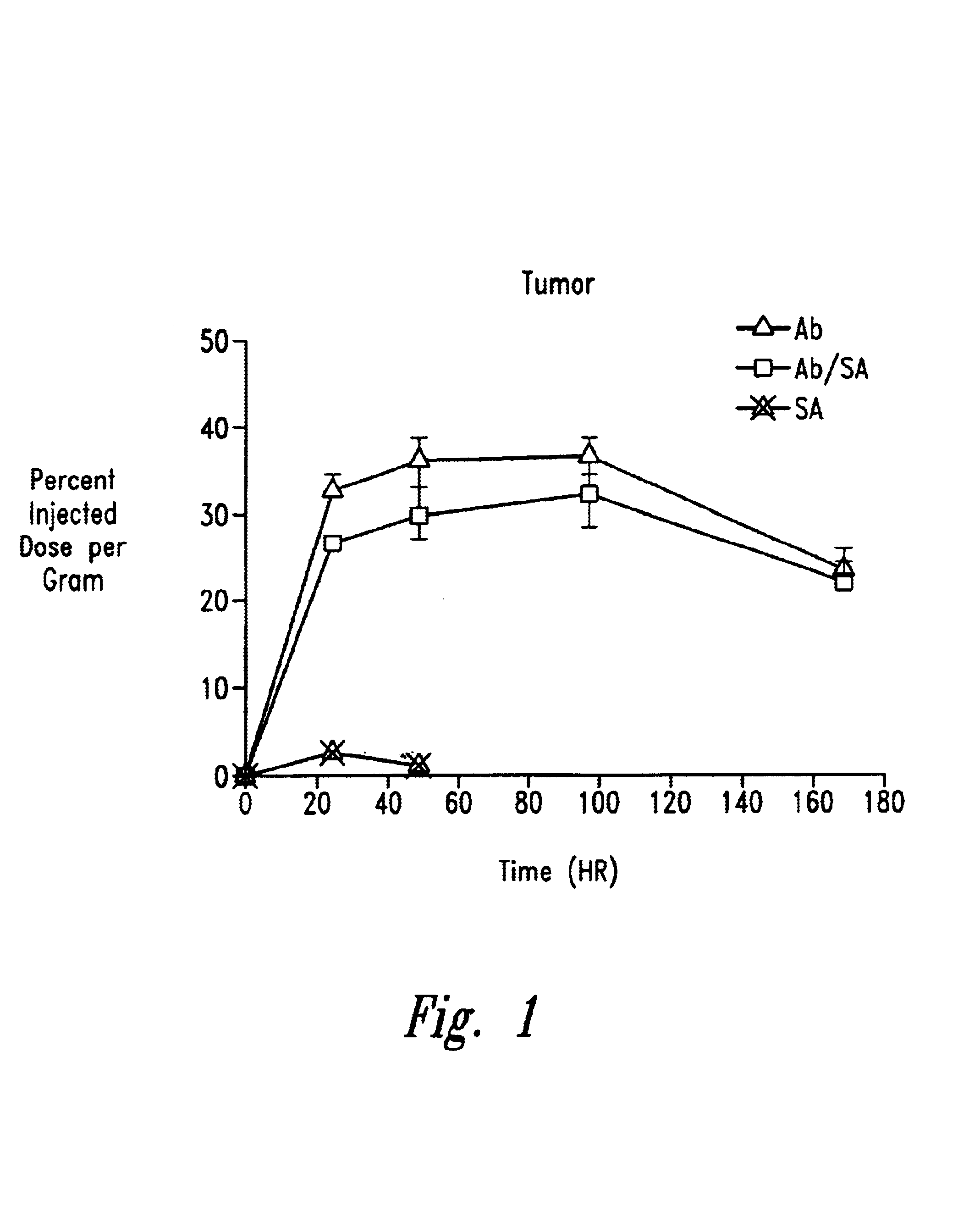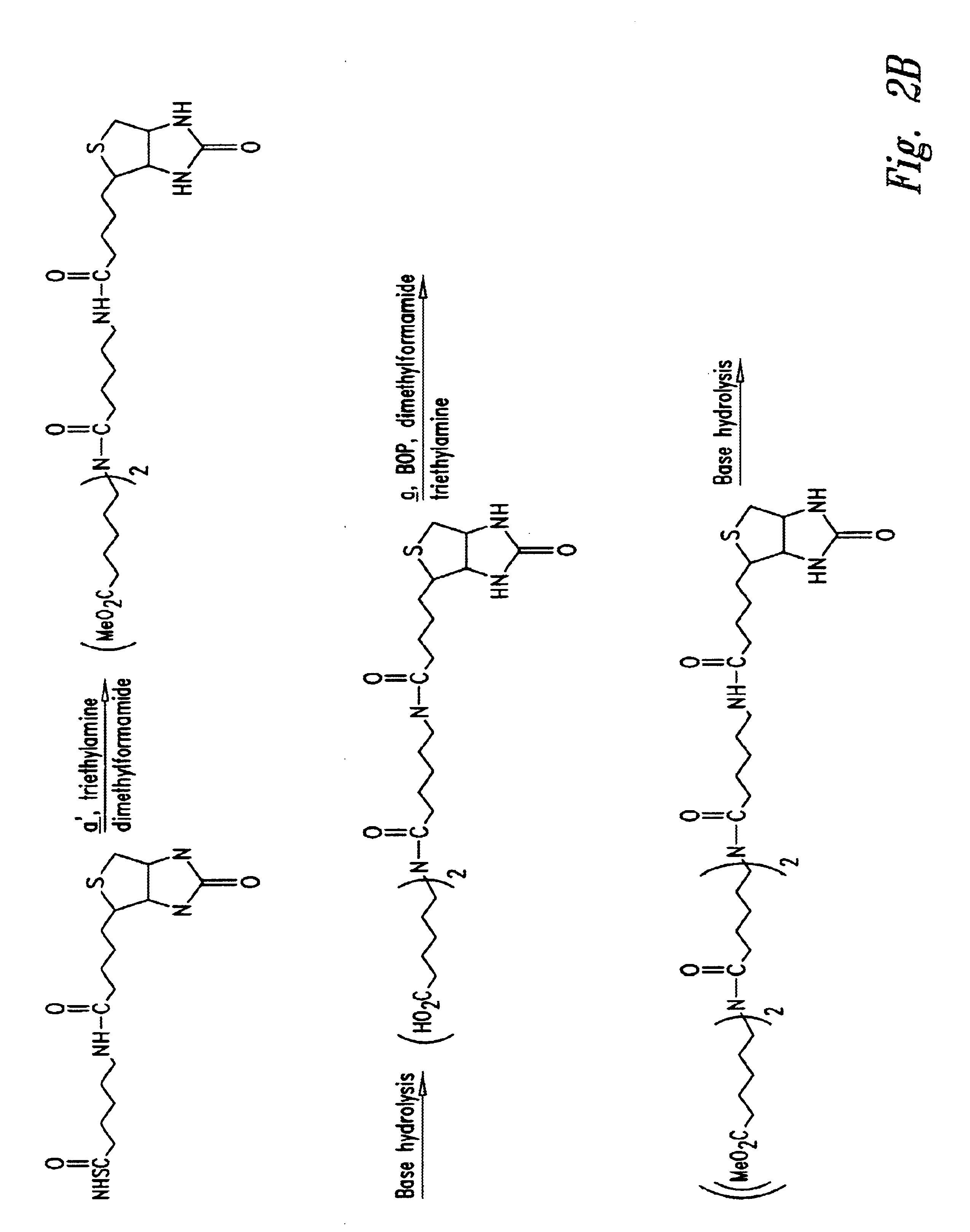Cluster clearing agents
a clearing agent and cluster technology, applied in the field of cluster clearing agents, can solve the problems of limited conventional cancer therapy, low targeting ratio, and limitation of systemic administration of chemotherapeutic agents, and achieve the effect of reducing the risk of side effects
- Summary
- Abstract
- Description
- Claims
- Application Information
AI Technical Summary
Benefits of technology
Problems solved by technology
Method used
Image
Examples
example i
Targeting Moiety-Anti-Ligand Conjugate for Two-Step Pretargeting In Vivo
[0157]A. Preparation of SMCC-derivitized streptavidin.
[0158]31 mg (0.48 mol) streptavidin was dissolved in 9.0 ml PBS to prepare a final solution at 3.5 mg / ml. The pH of the solution was adjusted to 8.5 by addition of 0.9 ml of 0.5 M borate buffer, pH 8.5. A DMSO solution of SMCC (3.5 mg / ml) was prepared, and 477 l (4.8 mol) of this solution was added dropwise to the vortexing protein solution. After 30 minutes of stirring, the solution was purified by G-25 (PD-10, Pharmacia, Picastaway, N.J.) column chromatography to remove unreacted or hydrolyzed SMCC. The purified SMCC-derivitized streptavidin was isolated (28 mg, 1.67 mg / ml).
[0159]B. Preparation of DTT-reduced NR-LU-10. To 77 mg NR-LU-10 (0.42 mol) in 15.0 ml PBS was added 1.5 ml of 0.5 M borate buffer, pH 8.5. A DTT solution, at 400 mg / ml (165 l) was added to the protein solution. After stirring at room temperature for 30 minutes, the reduced antibody was p...
example ii
Synthesis of DOTA-Biotin Conjugates
[0170]A. Synthesis of Nitro-Benzyl-DOTA.
[0171]The synthesis of aminobenzyl-DOTA was conducted substantially in accordance with the procedure of McMurry et al., Bioconjugate Chem., 3: 108-117, 1992. The critical step in the prior art synthesis is the intermolecular cyclization between disuccinimidyl N-(tert-butoxycarbonyl)iminodiacetate and N-(2-aminoethyl)-4-nitrophenyl alaninamide to prepare 1-(tert-butoxycarbonyl)-5-(4-nitrobenzyl)-3,6,11-trioxo-1,4,7,10-tetraazacyclododecane. In other words, the critical step is the intermolecular cyclization between the bis-NHS ester and the diamine to give the cyclized dodecane. McMurry et al. conducted the cyclization step on a 140 mmol scale, dissolving each of the reagents in 100 ml DMF and adding via a syringe pump over 48 hours to a reaction pot containing 4 liters dioxanic.
[0172]A 5× scale-up of the McMurry et al. procedure was not practical in terms of reaction volume, addition rate and reaction time. P...
example iii
Clearing Agent Evaluation Experimentation
[0179]A. Galactose- and Biotin-Derivatization of Human Serum Albumin (HSA). HSA was evaluated because it exhibits the advantages of being both inexpensive and non-immunogenic. HSA was derivatized with varying levels of biotin (1-about 9 biotins / molecule) via analogous chemistry to that previously described with respect to AO. More specifically, to a solution of HSA available from Sigma Chemical Co. (5-10 mg / ml in PBS) was added 10% v / v 0.5 M sodium borate buffer, pH 8.5, followed by dropwise addition of a DMSO solution of NHS-LC-biotin (Sigma Chemical Co.) to the stirred solution at the desired molar offering (relative molar equivalents of reactants). The final percent DMSO in the reaction mixture should not exceed 5%. After stirring for 1 hour at room temperature, the reaction was complete. A 90% incorporation efficiency for biotin on HSA was generally observed. As a result, if 3 molar equivalences of the NHS ester of LC-biotin was introduce...
PUM
| Property | Measurement | Unit |
|---|---|---|
| molecular mass | aaaaa | aaaaa |
| molecular weight | aaaaa | aaaaa |
| molecular weight | aaaaa | aaaaa |
Abstract
Description
Claims
Application Information
 Login to View More
Login to View More - R&D
- Intellectual Property
- Life Sciences
- Materials
- Tech Scout
- Unparalleled Data Quality
- Higher Quality Content
- 60% Fewer Hallucinations
Browse by: Latest US Patents, China's latest patents, Technical Efficacy Thesaurus, Application Domain, Technology Topic, Popular Technical Reports.
© 2025 PatSnap. All rights reserved.Legal|Privacy policy|Modern Slavery Act Transparency Statement|Sitemap|About US| Contact US: help@patsnap.com



